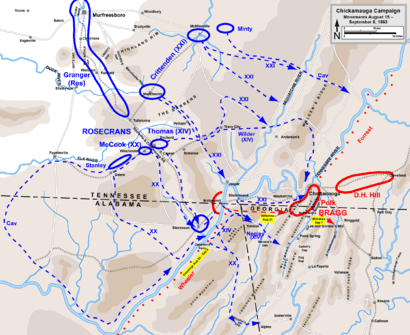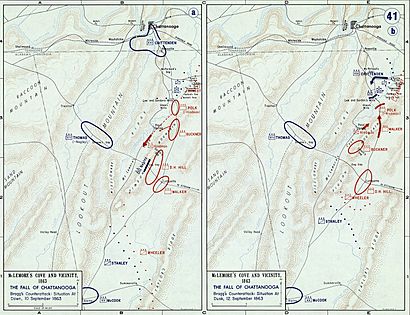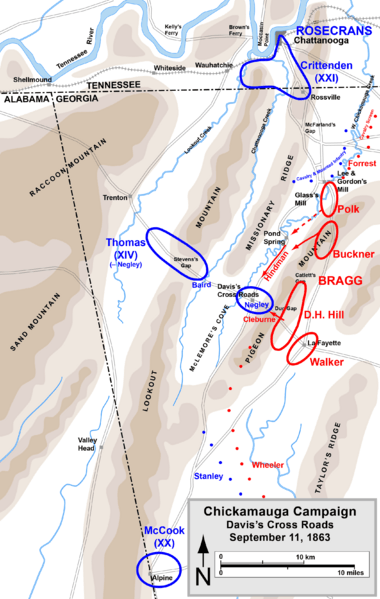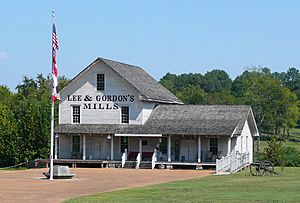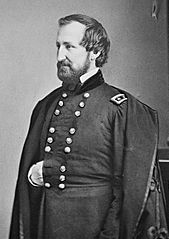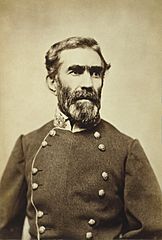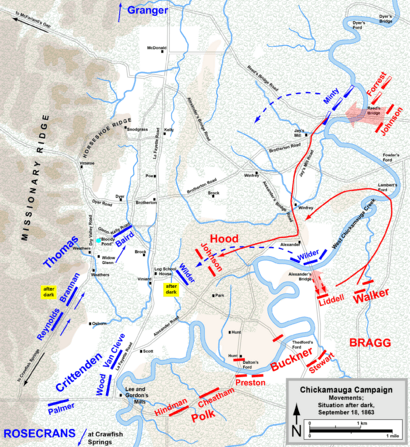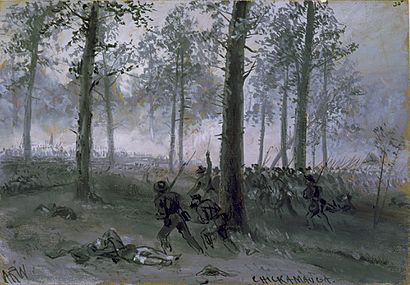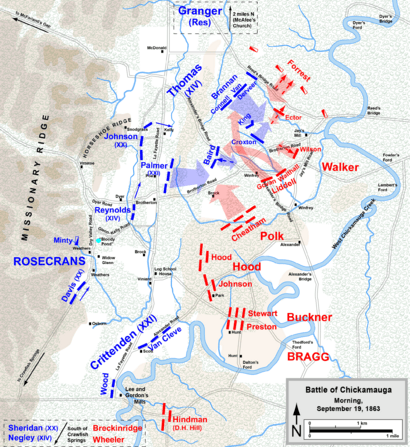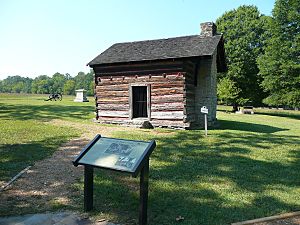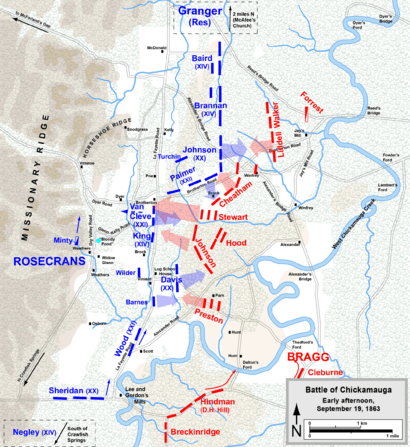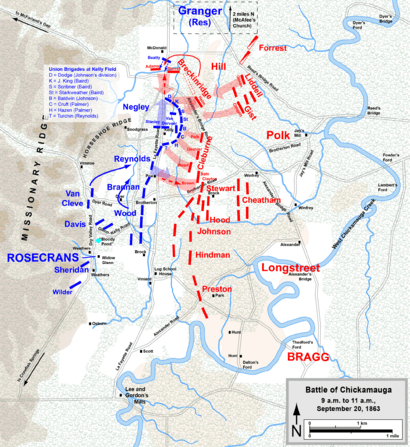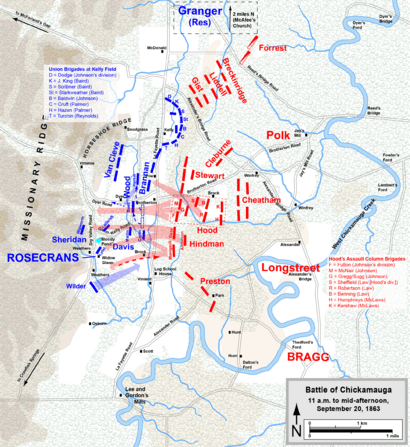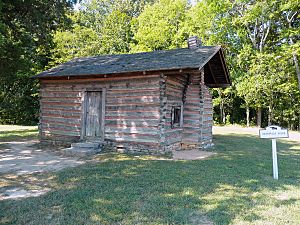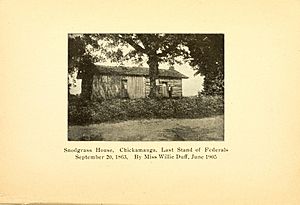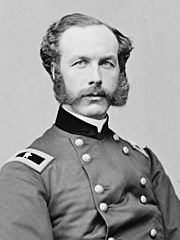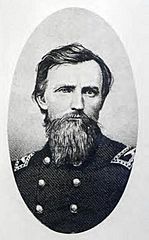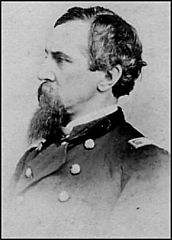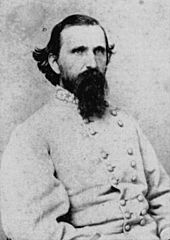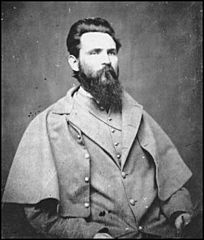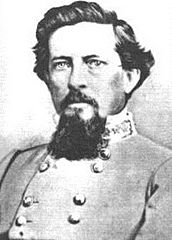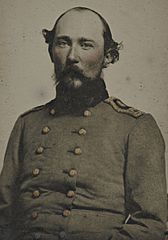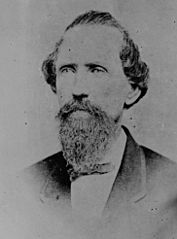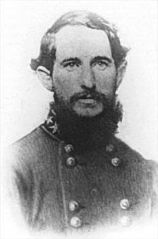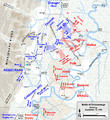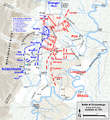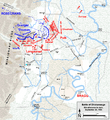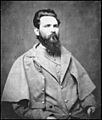Battle of Chickamauga facts for kids
Quick facts for kids Battle of Chickamauga |
|||||||
|---|---|---|---|---|---|---|---|
| Part of the Western Theater of the American Civil War | |||||||
 The Battle of Chickamauga by Kurz & Allison |
|||||||
|
|||||||
| Belligerents | |||||||
| Commanders and leaders | |||||||
| Units involved | |||||||
| Army of the Cumberland | Army of Tennessee | ||||||
| Strength | |||||||
| ~60,000 | ~65,000 | ||||||
| Casualties and losses | |||||||
| 17,170
1,857 killed
9,956 wounded 5,157 captured or missing |
18,454
2,312 killed
14,674 wounded 1,468 captured or missing |
||||||
The Battle of Chickamauga was a major fight during the American Civil War. It happened from September 18 to 20, 1863, in northwestern Georgia. This battle was a big part of the Chickamauga campaign, which was a Union Army effort to push Confederate forces out of Tennessee and Georgia.
It was the first big battle of the war fought in Georgia. It also became the most significant defeat for the Union Army in the Western Theater. Only the Battle of Gettysburg had more soldiers hurt or killed.
The battle was fought between the Army of the Cumberland, led by Maj. Gen. William Rosecrans for the Union, and the Confederate Army of Tennessee, led by Gen. Braxton Bragg. The battle is named after Chickamauga Creek, which flows near the battlefield.
After a successful campaign earlier in the summer, General Rosecrans wanted to force the Confederates out of Chattanooga. In early September, he gathered his troops and pushed Bragg's army out of Chattanooga. Bragg decided to fight back. He planned to attack a part of Rosecrans's army, defeat it, and then retake Chattanooga.
On September 18, Bragg's cavalry and infantry started fighting Union cavalry. The Confederates tried to cross the West Chickamauga Creek at places like Alexander's Bridge and Reed's Bridge.
The main fighting began on the morning of September 19. Bragg's soldiers attacked hard but could not break the Union lines. The next day, Bragg attacked again. In the late morning, Rosecrans got wrong information that there was a gap in his line. When he moved his troops to fix this supposed gap, he accidentally created a real one. Right into this opening charged a large Confederate force led by Lt. Gen. James Longstreet. This attack broke a third of the Union army, including Rosecrans himself, who left the battlefield.
Union soldiers who remained gathered on Horseshoe Ridge, also known as "Snodgrass Hill." Maj. Gen. George Henry Thomas took command of these remaining forces. Even though the Confederates attacked many times, Thomas and his men held their ground until nightfall. Union forces then pulled back to Chattanooga. The Confederates took over the surrounding hills, starting a siege of the city.
Contents
The Name "Chickamauga"
The battle is named after West Chickamauga Creek. Many people say that "Chickamauga" is a Cherokee word meaning "river of death." Some historians say this is a "loose translation." Other possible meanings include "stagnant water" or "good country."
One idea is that the name "river of death" came from a time when the Cherokee people got smallpox there. Another idea is that the word Chickamauga comes from a Chickasaw word, chokma, meaning "be good." The Chickasaw town of Chickamauga was located near Lookout Mountain.
Why the Battle Happened
Setting the Scene
In the summer of 1863, Union General Rosecrans had a big success in the Tullahoma campaign. He outsmarted Confederate General Bragg and forced him to leave Middle Tennessee and move to Chattanooga. Rosecrans's army had very few casualties.
Leaders in Washington, D.C., including President Abraham Lincoln, wanted Rosecrans to capture Chattanooga quickly. Taking Chattanooga was important because it would open the way for the Union to move towards Atlanta, a key city in the South. Chattanooga was a vital railroad hub and a manufacturing center. It was also a strong defensive position, surrounded by mountains like Lookout Mountain and Missionary Ridge.
General Bragg's Confederate Army of Tennessee had about 52,000 men. Later, more troops joined him, bringing his total to nearly 70,000. However, some of Bragg's new commanders did not respect him, which caused problems later on.
The Confederate government decided to send more soldiers to Bragg from other parts of the war. Lt. Gen. James Longstreet and two divisions from his corps came from Virginia. This was a big move, as it was the first time the Confederates moved so many troops from one area to another to gain an advantage. Bragg was happy with these reinforcements and planned to attack the Union Army as soon as he had enough strength.
Union's Plan to Advance
General Rosecrans faced big challenges in moving his army. The land was rough, with bad roads and little food for his soldiers. If Bragg attacked, Rosecrans would be in a tough spot. But Washington wanted him to move quickly.
Rosecrans planned to cross the Cumberland Plateau, then the Tennessee River. He knew crossing the wide river with enemy resistance would be hard. So, he came up with a trick: he would distract Bragg north of Chattanooga while his army crossed the river downstream.
His army would then advance on a wide front through the mountains. Different parts of his army would move in different directions. The XXI Corps would go towards Chattanooga from the west. The XIV Corps would cross Lookout Mountain south of the city. The XX Corps would go even further southeast to cut off Bragg's supply lines from Atlanta. If this plan worked, Bragg would have to leave Chattanooga or be trapped.
Crossing the Tennessee River
Rosecrans's army started moving on August 16. It took a week to reach the Tennessee River. Meanwhile, the Union's trick worked. A brigade of mounted infantry, led by Col. John T. Wilder, made loud noises and sent wood downstream north of Chattanooga. This made the Confederates think the Union was building rafts to cross there. Union artillery also shelled Chattanooga for two weeks. Bragg believed the Union would cross north of the city.
The Union army crossed the Tennessee River in several places, building bridges. By September 4, almost all of Rosecrans's army had safely crossed. They then faced more mountains and bad roads.
The Confederate leaders were worried and sent more troops to Bragg. Two divisions from Mississippi arrived, and Lt. Gen. James Longstreet came with two divisions from the Army of Northern Virginia. This brought more experienced soldiers to Bragg's army.
Into Georgia
Rosecrans's three army corps moved into Georgia on separate roads. On September 8, Bragg learned that Rosecrans was behind him, so he left Chattanooga and moved his army south towards LaFayette, Georgia. The Union army then took Chattanooga on September 9 without a fight.
Rosecrans thought Bragg was running away. But Bragg's army was actually waiting at LaFayette, about 20 miles south of Chattanooga. Bragg knew Rosecrans's army was spread out over 40 miles, too far apart to help each other. He planned to attack each isolated Union corps one by one.
Davis's Cross Roads
On September 10, Bragg tried to trap a Union division led by Maj. Gen. James S. Negley in McLemore's Cove. Bragg ordered two of his generals, Maj. Gen. Thomas C. Hindman and Lt. Gen. D.H. Hill, to attack Negley from different directions.
However, Bragg's orders were not followed well. Hill delayed his attack, claiming his general was sick and the road was blocked. Hindman, who had moved quickly, became cautious when Hill didn't attack. Bragg was furious that his orders were ignored and a chance was lost. By the time the Confederates were ready to attack on September 11, more Union troops had arrived, and Negley's division was able to escape.
Final Movements Before Battle
Realizing he had almost been trapped, Rosecrans stopped chasing Bragg and began to gather his scattered forces. He wanted to bring his army together to withdraw to Chattanooga safely.
Bragg, seeing another chance, ordered Lt. Gen. Leonidas Polk to attack a Union division at Lee and Gordon's Mill on September 13. But again, Polk did not attack as ordered, and by then, all of the Union corps had gathered there.
For the next four days, both armies tried to get into better positions. Rosecrans continued to bring his troops closer together. Bragg, now reinforced by Longstreet's troops from Virginia, decided to move his army north on September 18. He planned to force Rosecrans's army to fight or withdraw. Bragg wanted to move around the Union's left side and cross West Chickamauga Creek.
Commanders and Armies
| Opposing commanders |
|---|
|
Union Army
The Union Army of the Cumberland was led by William Rosecrans. It had about 60,000 soldiers.
- XIV Corps, led by Maj. Gen. George Henry Thomas.
- XX Corps, led by Maj. Gen. Alexander McDowell McCook.
- XXI Corps, led by Maj. Gen. Thomas Leonidas Crittenden.
- Reserve Corps, led by Maj. Gen. Gordon Granger.
- Cavalry Corps, led by Brig. Gen. Robert B. Mitchell.
Confederate Army
The Confederate Army of Tennessee was led by Braxton Bragg. It had about 65,000 soldiers.
- Right Wing, led by Lt. Gen. Leonidas Polk.
- Left Wing, led by Lt. Gen. James Longstreet.
- Cavalry Corps, led by Maj. Gen. Joseph Wheeler.
- Second Cavalry Corps, led by Brig. Gen. Nathan Bedford Forrest.
The Confederate army was reorganized into two "Wings" on the night of September 19, after Longstreet arrived. Before that, commanders reported directly to Bragg.
The Battle Begins
September 18: Skirmishes Before the Main Fight
On September 18, Confederate troops began moving. Brig. Gen. Bushrod Johnson's division took a wrong road but eventually headed towards Reed's Bridge. There, they met Union cavalry. The Union soldiers, outnumbered, pulled back across the bridge but couldn't destroy it. Later, Maj. Gen. John Bell Hood took command of this Confederate column.
At Alexander's Bridge, Union mounted infantry, armed with Spencer repeating rifles, held off a Confederate brigade for a while. But the Confederates found another crossing point and got across the creek.
By nightfall, the Confederates had crossed the creek but were behind schedule and spread out. Rosecrans, seeing the dust from the Confederate movements, realized Bragg's plan. He ordered his generals, Thomas and McCook, to move and support Crittenden.
September 19: The First Day of Battle
The Battle of Chickamauga started almost by accident on the morning of September 19. Union soldiers from Maj. Gen. Gordon Granger's Reserve Corps went looking for water near Jay's Mill. They ran into Confederate cavalry. Thinking it was a small Confederate force, Union Maj. Gen. George Henry Thomas ordered a division to attack it.
This led to a bigger fight. As more troops from both sides joined, the battle spread. Union and Confederate divisions clashed in the thick woods. The fighting was very confusing because the forest made it hard for officers to see what was happening. It became a "soldiers' battle," where small groups fought fiercely without clear orders from above.
Bragg had planned to attack the Union's left side. But because of the accidental start, he began sending many reinforcements to his right flank (the northern part of the battlefield). Union forces also brought in more troops. Divisions from both sides attacked and counterattacked throughout the day.
In the afternoon, Confederate Maj. Gen. Alexander P. Stewart's division attacked, pushing through the Union line near the Brotherton and Dyer fields. This created a big hole in the Union defenses. However, Stewart didn't have enough troops to hold this position and had to pull back.
Later, Brig. Gen. Bushrod Johnson's Confederate division attacked, pushing Union troops back towards the LaFayette Road. The fighting was so close to Rosecrans's headquarters that his staff could barely hear each other. Union Brig. Gen. John T. Wilder's men, armed with repeating rifles, managed to hold back the Confederates.
As darkness fell, Bragg ordered Maj. Gen. Patrick Cleburne's division to attack the Union right flank. The attack was chaotic in the dark and smoky woods. Both sides accidentally fired on their own men. By 9 p.m., Cleburne's men had pushed the Union back, but the fighting stopped for the night.
The first day of the battle was very costly. Historians estimate that between 6,000 and 9,000 Confederates and about 7,000 Union soldiers were killed, wounded, or captured.
September 20: The Second Day of Battle
On the night of September 19, Bragg reorganized his army into two "wings." Lt. Gen. Leonidas Polk commanded the Right Wing, and Lt. Gen. James Longstreet commanded the Left Wing. Bragg ordered Polk to attack the Union left flank at daybreak. However, Polk's attack was delayed by several hours.
Meanwhile, Union General Rosecrans held a meeting with his commanders. His army was badly hurt and outnumbered. He decided the army must stay and defend its position. Thomas's men had built strong defenses overnight using logs.
The battle on the second day finally began around 9:30 a.m. Confederate divisions, including those of Maj. Gen. John C. Breckinridge and Maj. Gen. Patrick Cleburne, attacked the Union left flank. The Confederates faced strong resistance from Thomas's breastworks. Breckinridge's men found the end of the Union line and tried to move around it, but Union reinforcements pushed them back.
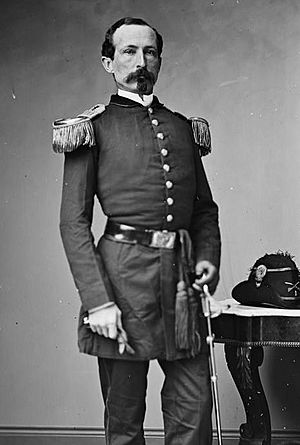
Around 10:50 a.m., a critical mistake happened on the Union side. General Rosecrans, thinking there was a gap in his line, ordered Brig. Gen. Thomas J. Wood to move his division. Wood was confused because another division was still in the way, but he followed the order. When Wood's division pulled out of the line, it created a huge, accidental gap.
At the exact same moment, Lt. Gen. James Longstreet launched a massive attack with 10,000 Confederate soldiers. His troops, led by Brig. Gen. Bushrod Johnson's division, charged directly into the gap Wood had just created. This was a devastating blow to the Union army. Confederate soldiers poured through the opening, capturing Union cannons and causing panic.
Maj. Gen. John Bell Hood, leading Longstreet's main attack, was seriously wounded in the leg during this charge. Many Union soldiers ran in disorder. Rosecrans, his chief of staff, and other generals were caught in the retreat and headed back towards Chattanooga.
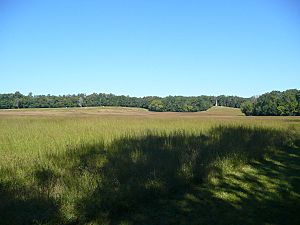
However, not all Union soldiers fled. Maj. Gen. George Henry Thomas and his divisions still held their ground at Kelly Field. Many retreating Union soldiers rallied on Horseshoe Ridge, a strong defensive position. They quickly built makeshift defenses from fallen trees.
Maj. Gen. Gordon Granger, whose Reserve Corps was stationed a few miles north, heard the sounds of battle. Without waiting for orders, he sent two brigades to help Thomas. These fresh troops arrived just as the Confederates were attacking Horseshoe Ridge.
Throughout the afternoon, the Confederates launched many fierce attacks on Horseshoe Ridge. But Thomas and his men, reinforced by Granger's troops, held their position. Their stubborn defense earned Thomas the nickname "Rock of Chickamauga."
As darkness fell, Thomas received orders from Rosecrans to take command of the army and retreat. Thomas's divisions slowly pulled back from Kelly Field, followed by the troops on Horseshoe Ridge. Some Union regiments, low on ammunition, fought with bayonets until they were surrounded and forced to surrender.
Aftermath of the Battle
Thomas successfully withdrew the remaining Union forces to positions around Rossville Gap after dark. His strong stand saved the Union army from complete destruction.
General Bragg's army camped for the night, not realizing that the Union army had escaped. Bragg was unable to chase them effectively because his troops were tired, many horses were gone, and he had no bridges to cross the river.
Casualties
| Senior officer casualties |
|---|
|
The Battle of Chickamauga was very costly for both sides. The Union lost about 16,170 soldiers (killed, wounded, or missing). The Confederates lost about 18,454 soldiers. These were the highest losses in the Western Theater and the second-highest in the entire war, after Gettysburg.
Several generals were killed or seriously wounded. Confederate General John Bell Hood, who had already lost the use of his left arm at Gettysburg, was shot in the leg and had to have it amputated.
Even though the Confederates won the battle by driving the Union army from the field, Bragg did not achieve his main goals of destroying Rosecrans's army or taking back control of East Tennessee. The Confederate army also suffered heavy losses that they could not easily replace.
Aftermath and Changes in Command
On September 21, Rosecrans's army went into Chattanooga and set up strong defenses. However, their supply lines were cut off, and the Confederates began to besiege the city.
Because he couldn't break the siege, Rosecrans was replaced as commander of the Army of the Cumberland by George Henry Thomas on October 19. On the Confederate side, Bragg had problems with his generals who he felt had failed him. Some of his generals tried to get him removed from command.
Longstreet's corps was later sent to fight in the Knoxville Campaign, which weakened Bragg's army at Chattanooga.
What Happened Next
The Chickamauga Campaign was followed by the Battles for Chattanooga. Union forces, now led by Maj. Gen. Ulysses S. Grant, broke Bragg's siege on the city. This forced the Confederate Army of Tennessee to retreat and opened the way for Maj. Gen. William T. Sherman's Atlanta Campaign in 1864.
Battlefield Today
|
Chickamauga and Chattanooga National Military Park
|
|

Cannon row
|
|
| Location | S of Chattanooga on U.S. 27, Fort Oglethorpe, Georgia |
|---|---|
| Built | 1890 |
| Architect | War Department; National Park Service |
| Architectural style | Bungalow/craftsman, Single-pen log cabin |
| NRHP reference No. | 66000274 |
| Added to NRHP | October 15, 1966 |
Much of the Chickamauga battlefield is now part of the Chickamauga and Chattanooga National Military Park, managed by the National Park Service. This park helps preserve the history of the battle. Groups like the American Battlefield Trust have also helped save parts of the battlefield.
Chickamauga in Stories and Movies
- The short story "Chickamauga" by Ambrose Bierce was published in 1891. A French filmmaker made a short film based on it in 1962.
- Thomas Wolfe also published a short story called "Chickamauga" in 1937.
Images for kids
-
Maj. Gen. William Rosecrans, USA
-
Gen. Braxton Bragg, CSA
-
Brig. Gen. Thomas J. Wood chose to obey a questionable order from Rosecrans to reposition his division. In doing so, he opened up a crucial gap in the Union lines.
-
Horseshoe Ridge, Chickamauga and Chattanooga National Military Park, 2008
-
Brig. Gen. John C. Starkweather, wounded
-
Brig. Gen. John T. Croxton, wounded
-
Brig. Gen. William H. Lytle, killed
-
Col. Hans C. Heg, mortally wounded
-
Col. Luther P. Bradley, wounded
-
Maj. Gen. John B. Hood, wounded
-
Brig. Gen. James Deshler, killed
-
Brig. Gen. Daniel W. Adams, wounded and captured
See also
 In Spanish: Batalla de Chickamauga para niños
In Spanish: Batalla de Chickamauga para niños



